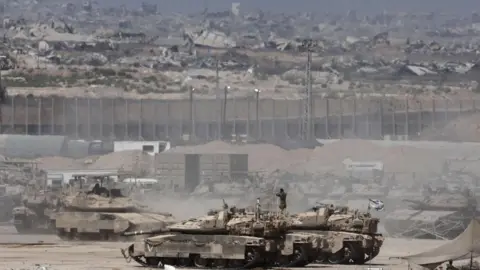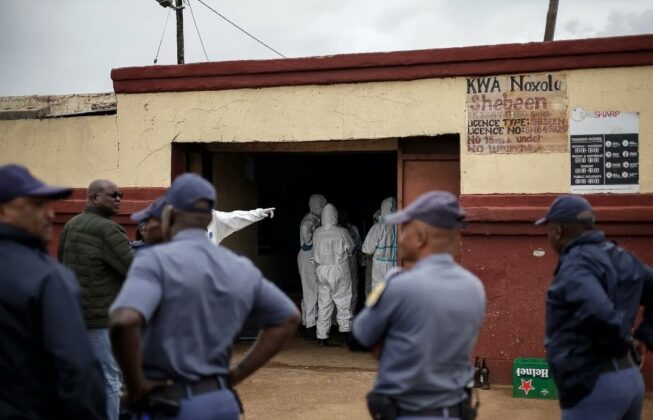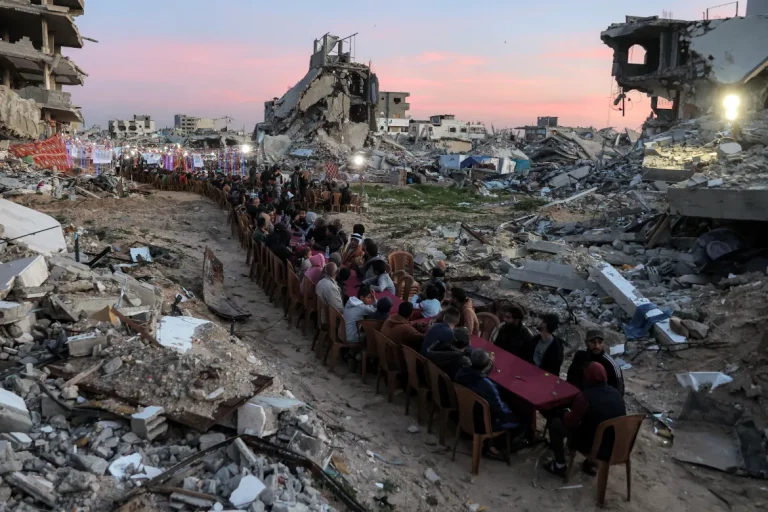
Smoke rises over Gaza City as Israeli tanks and airstrikes advance, leaving destruction in their wake. Image: BBC News.
(The Post News)- Israel controls 40% of Gaza City, a senior military spokesperson confirmed on Thursday, as tanks and airstrikes forced thousands of Palestinians from their homes while others defiantly chose to remain among the ruins. The latest developments mark a significant escalation in Israel’s military campaign to dismantle Hamas’ stronghold in Gaza, with heavy casualties reported across the city.
Israel Controls 40% of Gaza City—Military Confirms Strategic Gains
Brigadier General Effie Defrin, speaking at a press conference, announced the military’s latest territorial gains. “We continue to damage Hamas’ infrastructure. Today we hold 40% of the territory of Gaza City,” Defrin said, specifically naming the Zeitoun and Sheikh Radwan neighborhoods. “The operation will continue to expand and intensify in the coming days. We will continue to pursue Hamas everywhere.”
Defrin’s remarks underscore Israel’s determination to push deeper into Gaza City. He added that the campaign’s objectives remain the same: the return of Israeli hostages and the dismantling of Hamas’ rule in Gaza.
The Human Cost
Gaza health authorities reported at least 53 Palestinians killed on Thursday alone, most of them in Gaza City. Residents described relentless bombardment in the Zeitoun, Sabra, Tuffah, and Shejaia districts. Tanks pushed into the eastern parts of Sheikh Radwan, destroying homes and triggering fires in tent encampments where displaced families had been sheltering.
In one of the day’s deadliest strikes, eight people were killed and dozens were wounded in the Tuffah neighborhood. “The Israeli occupation targeted a gathering of civilians and several homes in the Mashahra area of the Tuffah neighborhood—a fire belt that destroyed four buildings,” said Mahmoud Bassal, spokesperson for Gaza’s civil emergency service. “Even if the Israeli occupation issues warnings, there are no places that can accommodate the civilians; there are no alternate places for the people to go to.”
Defiance Amid Destruction
Despite the rising death toll, many residents are refusing to leave Gaza City. Some believe fleeing offers no real safety. “This time, I am not leaving my house. I want to die here. It doesn’t matter if we move out or stay. Tens of thousands of those who left their homes were killed by Israel too, so why bother?” said Um Nader, a mother of five, speaking via text message.
Strategic and Political Context
Israel launched its latest Gaza City offensive on August 10 as part of a broader plan to defeat Hamas militants in the areas where Israeli forces fought most heavily during the war’s initial phase. The decision to expand operations into central Gaza City was influenced by intelligence reports pointing to renewed militant activity in the area.
However, the campaign has also sparked heated debate inside Israel. Defrin confirmed reports that Chief of Staff Eyal Zamir told cabinet ministers that if no post-war governance plan is prepared, Israel might have no choice but to impose military rule in Gaza.
This suggestion has polarized Israeli politics. Far-right members of Prime Minister Benjamin Netanyahu’s coalition have pushed for re-establishing settlements in Gaza and permanent military control—proposals Netanyahu has publicly ruled out. The debate reflects growing friction between the military’s operational needs and political leaders’ long-term vision.
International Reaction
The humanitarian crisis triggered by the campaign has drawn global criticism. Human rights organizations have called for immediate ceasefires to allow aid to reach civilians. Several foreign governments have warned that Israel’s actions risk deepening instability in the region.
UN officials have repeatedly stated that safe evacuation routes must be guaranteed before telling civilians to move. Yet, aid groups report that evacuation corridors are often unsafe due to ongoing shelling.
Life Among the Ruins
Before the war, Gaza City was home to about a million people. Months of bombardment have left much of it in rubble. Yet, hundreds of thousands have returned to live among the ruins, particularly after Israel ordered evacuations from other parts of Gaza.
Israeli officials say 70,000 civilians have left Gaza City for safer areas in the south, but Palestinian authorities estimate the number is significantly lower, leaving many thousands still in harm’s way.
Why This Matters
The battle for Gaza City has become one of the defining stages of the conflict. Israel’s control over 40% of the city represents a major military milestone, but it also raises questions about what comes next.
Will Israel attempt to hold Gaza City indefinitely, or will it eventually withdraw after achieving its objectives? Without a clear plan for governance, experts warn the region could fall into deeper chaos, leading to renewed cycles of violence. A fact that represents both a tactical victory and a humanitarian disaster. The next steps taken by Israeli leaders will determine whether this campaign leads to a decisive resolution or prolongs Gaza’s suffering.
As the bombardment continues, the voices of civilians like Um Nader remind the world that behind every military statistic are human lives, caught in the crossfire, with nowhere safe to turn.



